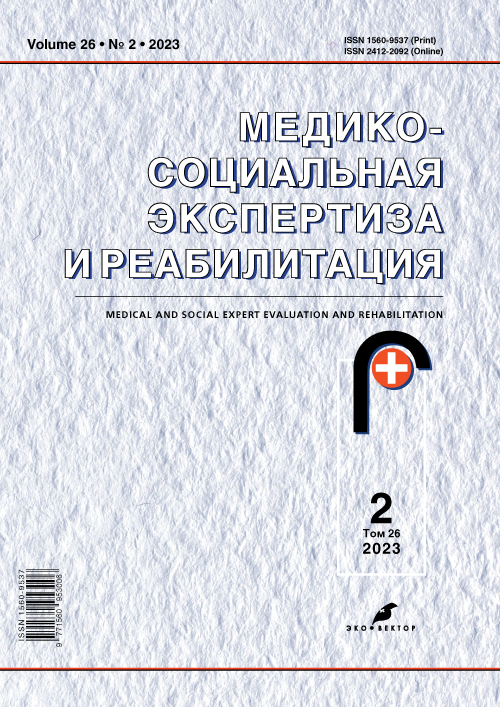Assessment of functioning indicators of people with disability and impaired neuromuscular, skeletal, and movement-related functions based on the International Classification of Functioning, Disability, and Health considering environmental barriers
- Authors: Povorinskii A.A.1, Vladimirova O.N.1, Shoshmin A.V.2, Kulinich T.S.3
-
Affiliations:
- St. Petersburg Institute of advanced training of doctors-experts
- Federal Scientific Center of Rehabilitation of the Disabled named after G.A. Albrecht
- Main Bureau of Medical and Social Expertise in the Leningrad Region
- Issue: Vol 26, No 2 (2023)
- Pages: 101-110
- Section: Original study articles
- URL: https://rjmseer.com/1560-9537/article/view/321191
- DOI: https://doi.org/10.17816/MSER321191
- ID: 321191
Cite item
Abstract
BACKGROUND: The need and realization of the rights to rehabilitation of people with disability is a key guideline in building a system of rehabilitation and habilitation in the Russian Federation. The need for comprehensive rehabilitation for disorders of neuromuscular, skeletal, and movement-related functions (NSMFs) has not yet been fully studied.
AIM: To assess functioning indicators of persons with disability and impaired NSMFs based on the International Classification of Functioning, Disability, and Health (ICF) considering environmental barriers.
MATERIALS AND METHODS: A continuous controlled medical and social study was conducted. The study enrolled 257 respondents recognized as having a disability, which were divided into two groups. The target group (n=137) consisted of patients with NSMFs receiving rehabilitation services at a rehabilitation center, and the control group included 120 respondents with NSMFs who passed the initial examination at the Bureau of Medical and Social Expertise.
RESULTS: Despite the high need for comprehensive rehabilitation measures for people with disability and NSMFs of all age groups, patients with milder disease receive the preferential right to rehabilitation.
CONCLUSIONS: The results show that the use of ICF determinants in the description of functional and structural disorders and the main barriers at the stages of medical and social examination allows the identification of existing barriers in people with disability and more accurately and objectively determine the need for rehabilitation measures.
Full Text
About the authors
Anton A. Povorinskii
St. Petersburg Institute of advanced training of doctors-experts
Author for correspondence.
Email: povan@mail.ru
ORCID iD: 0000-0002-5059-2177
Russian Federation, St. Petersburg
Oksana N. Vladimirova
St. Petersburg Institute of advanced training of doctors-experts
Email: vladox1204@yandex.ru
ORCID iD: 0000-0001-6692-2882
md, dr. sci. (med.), assistant professor
Russian Federation, St. PetersburgAleksander V. Shoshmin
Federal Scientific Center of Rehabilitation of the Disabled named after G.A. Albrecht
Email: shoshminav@mail.ru
ORCID iD: 0000-0003-1928-275X
cand. sci. (biol.)
Russian Federation, St. PetersburgTatyana S. Kulinich
Main Bureau of Medical and Social Expertise in the Leningrad Region
Email: kulinich.ts@lomse.ru
ORCID iD: 0000-0003-4887-4404
Russian Federation, St. Petersburg
References
- WHO Newsletter. Disability [Internet]. Available from: https://www.who.int/ru/news-room/fact-sheets/detail/disability-and-health Accessed: 27.02.2023. (In Russ).
- World Health Organization and World Bank, World report on disability 2011, WHO/NMH/VIP/11.01, World Health Organization. Available from: https://apps.who.int/iris/bitstream/handle/10665/87365/WHO_NMH_VIP_11.04_rus.pdf?sequence=1&isAllowed=y Accessed: 27.02.2023.
- Federal Law of Russian Federation № 181-FZ of 24 November 1995 (as amended on 26.05.2021). «On Social protection of disabled persons in the Russian Federation». Available from: http://www.consultant.ru/document/cons_doc_LAW_8559 Accessed: 17.08.2022. (In Russ).
- Nizinkovskaya VV. State policy and regulatory justification of social protection of disabled people. Bulletin of the Taganrog Institute of Management and Economics. 2019;30(2):50–53. Available from: https://cyberleninka.ru/article/n/gosudarstvennaya-politika-i-normativno-pravovoe-obosnovanie-sotsialnoy-zaschity-invalidov/viewer Accessed: 18.08.2022. (In Russ).
- Decree of the Government of the Russian Federation № 3711-r of 18 December 2021/ «The concept of development in the Russian Federation of a system of comprehensive rehabilitation and habilitation of disabled people, including disabled children, for the period up to 2025». Available from: https://www.garant.ru/products/ipo/prime/doc/403212204/ Accessed: 28.12.2021. (In Russ).
- Order of the Ministry of Labor and Social Protection of the Russian Federation № 664n of 29 September 2014. «On classifications and criteria used in the implementation of medical and social expertise of citizens by federal state institutions of medical and social expertise». Available from: https://www.garant.ru/products/ipo/prime/doc/70707166/ Accessed: 18.08.2022. (In Russ).
- Spiridonova VS, Sklyarenko RT, Chistyakova NP, Penina GO, Nepomnyashchaya SA. Clinical, functional and quantitative assessment of the severity of persistent functional disorders in diseases of the musculoskeletal system and connective tissue in children. Bulletin of the International Scientific Surgical Association. 2017;6(4). Available from: https://cyberleninka.ru/article/n/kliniko-funktsionalnaya-i-kolichestvennaya-otsenka-stepeni-vyrazhennosti-stoykih-narusheniy-funktsiy-pri-boleznyah-kostno-myshechnoy/viewer. Accessed: 18.08.2022. (In Russ).
- Vladimirova ON, Afonina KP, Ponomarenko GN, Shoshmin AV. Organization of a system of comprehensive rehabilitation in the Russian Federation based on the study of the needs of disabled people. Medicine in Kuzbass. 2018;17(4):20–27. Available from: https://cyberleninka.ru/article/n/organizatsiya-sistemy-kompleksnoy-reabilitatsii-v-rossiyskoy-federatsii-na-osnove-izucheniya-potrebnostey-invalidov Accessed: 02.04.2022. (In Russ).
- Vladimirova ON, Shoshmin AV, Rozhko KN. Integration of international provisions into the system of complex rehabilitation and habilitation in the Russian Federation. Proceedings of the Scientific and practical conference «Complex rehabilitation and habilitation of disabled people»; 2020 Nov 27; St. Petersburg. St. Petersburg: TSIATSAN LLC; 2020. Р. 18–19. (In Russ).
- Vladimirova ON, Khodakovsky MD, Ishutina IN, Kozhushko LA, Starobina EM, Shoshmin AV, Tsarev AM, Sisneva ME, Urmancheeva MA, Egel OO. Theoretical foundations for assessing the ability of persons with impaired mental functions to live independently, including with accompaniment. Medico-social expertise and rehabilitation. 2019;22(4):6–14. Available from: https://rjmseer.com/1560-9537/article/view/48952 Accessed: 30.09.2022. (In Russ). doi: 10.17816/MSER48952
- Shestakov VP, Svintsov AA, Chernyakina TS, Raduto VI. The main directions of improving the legislation of the Russian Federation in accordance with the requirements of the Convention on the Rights of Persons with Disabilities. Social and Pension law. 2019;(2):37–42. Available from: http://old-www.tverlib.ru/document/invalids_and_society/shestakov_osnovnye_napravleniya.pdf Accessed: 30.09.2022. (In Russ).
- International classification of functioning, disability and Health (with amendments and additions as of 2016): draft.
- Bodrova RA, Aukhadeev EI, Akhunova RR, Khusainova ER. Approaches to the choice of technical means of rehabilitation with the help of ICF. Physical and rehabilitation medicine, medical rehabilitation. 2019;(4). Available from: https://cyberleninka.ru/article/n/podhody-k-vyboru-tehnicheskih-sredstv-reabilitatsii-s-pomoschyu-mkf Accessed: 02.04.2022. (In Russ). doi: 10.36425/2658-6843-2019-4-64-71
- Bodrova RA, Iksanov HV. Methodological aspects of the International classification of functioning, disability and health in the development of individual rehabilitation or habilitation programs. Vesti nauchnyh dostizhenij. Medicine and pharmacy. 2019;(1):33–38. Available from: https://cyberleninka.ru/article/n/metodologicheskie-aspekty-mezhdunarodnoy-klassifikatsii-funktsionirovaniya-ogranicheniy-zhiznedeyatelnosti-i-zdorovya-pri/viewer Accessed: 27.02.2023. (In Russ). doi: 10.36616/2713-1718-2019-1-33-38
Supplementary files










